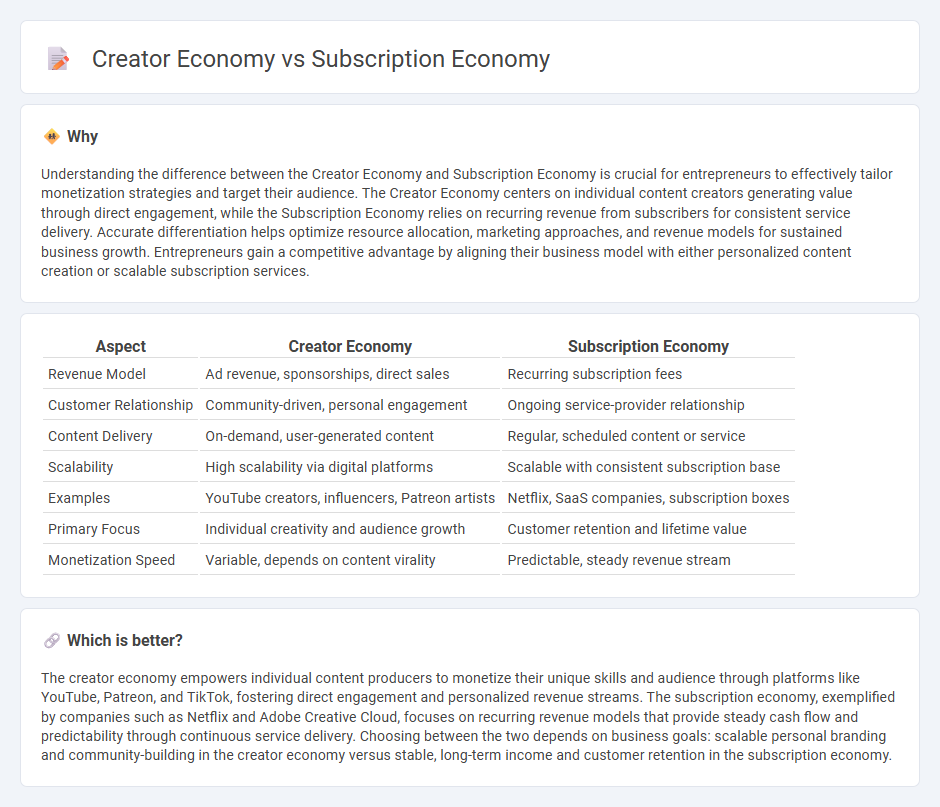
Entrepreneurship thrives in both the creator economy and the subscription economy, each offering distinct business models and revenue streams. The creator economy empowers individuals to monetize content through platforms like YouTube and Patreon, while the subscription economy focuses on recurring revenue from services such as Netflix and Spotify. Explore the dynamics of these evolving economies to understand new entrepreneurial opportunities.
Why it is important
Understanding the difference between the Creator Economy and Subscription Economy is crucial for entrepreneurs to effectively tailor monetization strategies and target their audience. The Creator Economy centers on individual content creators generating value through direct engagement, while the Subscription Economy relies on recurring revenue from subscribers for consistent service delivery. Accurate differentiation helps optimize resource allocation, marketing approaches, and revenue models for sustained business growth. Entrepreneurs gain a competitive advantage by aligning their business model with either personalized content creation or scalable subscription services.
Comparison Table
| Aspect | Creator Economy | Subscription Economy |
|---|---|---|
| Revenue Model | Ad revenue, sponsorships, direct sales | Recurring subscription fees |
| Customer Relationship | Community-driven, personal engagement | Ongoing service-provider relationship |
| Content Delivery | On-demand, user-generated content | Regular, scheduled content or service |
| Scalability | High scalability via digital platforms | Scalable with consistent subscription base |
| Examples | YouTube creators, influencers, Patreon artists | Netflix, SaaS companies, subscription boxes |
| Primary Focus | Individual creativity and audience growth | Customer retention and lifetime value |
| Monetization Speed | Variable, depends on content virality | Predictable, steady revenue stream |
Which is better?
The creator economy empowers individual content producers to monetize their unique skills and audience through platforms like YouTube, Patreon, and TikTok, fostering direct engagement and personalized revenue streams. The subscription economy, exemplified by companies such as Netflix and Adobe Creative Cloud, focuses on recurring revenue models that provide steady cash flow and predictability through continuous service delivery. Choosing between the two depends on business goals: scalable personal branding and community-building in the creator economy versus stable, long-term income and customer retention in the subscription economy.
Connection
The creator economy thrives on content producers monetizing their audiences through platforms that support direct engagement and personalized experiences. Subscription economy models provide a steady revenue stream for creators by enabling recurring payments for exclusive content, services, or products. This integration empowers entrepreneurs to scale their businesses sustainably while fostering deeper community connections.
Key Terms
Recurring Revenue
The subscription economy harnesses recurring revenue through automated, predictable payments enhancing customer retention and lifetime value. In contrast, the creator economy generates recurring revenue by leveraging personal brand loyalty and diverse income streams like memberships, exclusive content, and merchandise. Discover how optimizing recurring revenue models can elevate business growth in both economies.
Direct Monetization
The subscription economy drives recurring revenue through continuous access to curated content or services, emphasizing customer retention and lifetime value. In contrast, the creator economy centers on direct monetization methods like fan support, digital products, and exclusive experiences, empowering individual content creators to generate income independently. Explore how these models transform revenue streams in the digital landscape.
Platform Dependency
The subscription economy thrives on recurring revenue models where platforms maintain control over user access and data, creating significant dependency for businesses on those ecosystems. In contrast, the creator economy emphasizes individual content creators building personal brands and direct audience engagement, reducing reliance on any single platform while leveraging multiple channels for monetization. Explore further to understand how platform dependency shapes strategies and opportunities in both economies.
Source and External Links
Rise of the subscription economy: What it is and how it works - The subscription economy is a shift from traditional ownership to paying for ongoing access to products or services, driving convenience, loyalty, and predictable revenue across industries like streaming, SaaS, vehicle rentals, and subscription boxes.
What is Subscription Economy? - DealHub - The subscription economy, driven by digital transformation and cloud technologies, replaces asset ownership with access, relying on consumption-based or flat-rate subscription business models for services like SaaS and streaming platforms.
The rise of subscription economy: a win-win for consumers and businesses - The subscription economy has surged 435% in the last decade, enabling companies to shift from pay-per-product to recurring revenue models with examples including media streaming, SaaS, subscription boxes, and luxury vehicle subscriptions.
 dowidth.com
dowidth.com